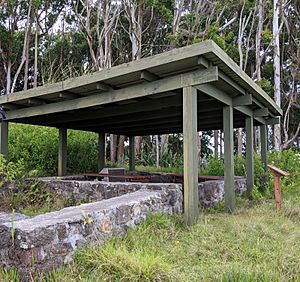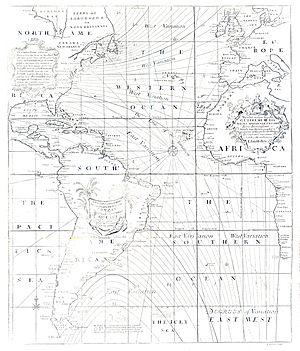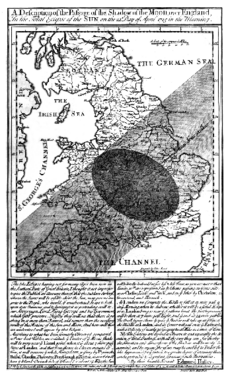Edmond Halley facts for kids
Quick facts for kids
Edmond Halley
|
|
|---|---|
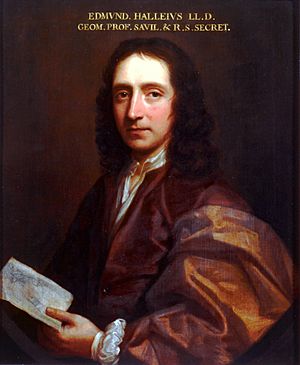
Portrait of Halley (c. 1690)
|
|
| Born | 8 November [O.S. 29 October] 1656 Haggerston, Middlesex, England
|
| Died | 25 January 1742 [O.S. 14 January 1741] (aged 85) |
| Resting place | St. Margaret's, Lee, South London |
| Nationality | English |
| Alma mater | The Queen's College, Oxford |
| Spouse(s) |
Mary Tooke
(m. 1682) |
| Children | Edmond Halley (d. 1742) Margaret (d. 1743) Richelle (d. 1748) |
| Scientific career | |
| Fields | Astronomy, mathematics, physics, cartography |
| Institutions | University of Oxford Royal Observatory, Greenwich |

Edmond Halley (born November 8, 1656 – died January 25, 1742) was a famous English astronomer, mathematician, and physicist. He is best known for predicting the return of the comet that now bears his name: Halley's Comet. He became the second Astronomer Royal in Britain in 1720.
Halley built an observatory on the island of Saint Helena in 1676–77. There, he created a detailed map of the stars in the southern sky. He also saw the planet Mercury pass in front of the Sun. This made him realize that watching Venus do the same could help measure distances in space. When he returned to England, he became a member of the Royal Society. He also earned a master's degree from Oxford with help from King Charles II.
Halley played a big role in getting Isaac Newton's important book, Philosophiæ Naturalis Principia Mathematica, published in 1687. He even helped pay for it! After observing a comet in 1682, Halley used Newton's laws of motion to figure out when it would return. He wrote about this in 1705. The comet was later named Halley's Comet, but he didn't live to see its predicted return in 1758.
Later in his life, Halley went on sea trips to study Earth's magnetism. In 1718, he discovered that "fixed" stars actually move slowly over time.
Contents
Early Life and Learning
Edmond Halley was born in Haggerston, England. His father, Edmond Halley Sr., was a rich soap-maker. From a young age, Halley loved mathematics. He went to St Paul's School, where he first became interested in astronomy.
In July 1673, he started studying at The Queen's College, Oxford. He even brought a large, 24-foot-long telescope with him! While still a student, Halley wrote papers about the Solar System and sunspots. He noticed that some star maps and planet positions were wrong. He even wrote to John Flamsteed, who was England's first Astronomer Royal, about it.
Amazing Discoveries and Inventions
Mapping the Stars and Planets
In 1676, Halley published his first paper about how planets move in their orbits. He was inspired by Flamsteed, who was making a map of the northern stars. Halley decided to map the stars in the southern sky. He left school to travel to the island of Saint Helena in the South Atlantic. King Charles II supported his journey.
Halley set up an observatory on the island. For over a year, he carefully watched the stars. He created the very first map of the southern sky. He also saw Mercury pass across the Sun. This made him realize that watching a planet cross the Sun could help measure huge distances in space. He thought watching Venus do this would be even better, but that wouldn't happen for many years.
Halley returned to England in 1678. He used his observations to create a map of the southern stars. He was only 22 years old when he became a member of the Royal Society. In 1679, he published his star map, which included 341 stars.
By 1681, scientists were starting to think that comets traveled in orbits, just like planets. In September 1682, Halley observed a comet that later became known as Halley's Comet. He studied its path and predicted it would return in 1758. This was a huge achievement!
In 1686, Halley published a paper and a map about trade winds and monsoons. He showed that the Sun's heat causes air to move around the Earth. His maps were very important for showing information visually.
Working with Isaac Newton
Halley was very interested in gravity. He wanted to understand how planets move. In 1684, he visited Isaac Newton at Cambridge. Newton had already figured out the math for how planets orbit, but he hadn't published it. Halley encouraged Newton to write down his ideas. He even paid for Newton's famous book, Philosophiæ Naturalis Principia Mathematica, to be published in 1687. This book changed how people understood the universe.
Diving Bells and Compasses
In 1691, Halley invented a diving bell. This was a device that allowed people to breathe underwater. Air was sent down from the surface in heavy barrels. Halley and five friends once stayed underwater for over an hour and a half in the River Thames! He kept improving his diving bell, eventually allowing people to stay underwater for more than 4 hours.
That same year, Halley showed off a simple working model of a magnetic compass. It had a liquid-filled case to stop the needle from wobbling.
Ideas About Earth
In 1692, Halley had a unique idea about the Earth. He thought it might be hollow! He imagined it had several layers, like an onion, with space and even light between them. He thought this could explain strange compass readings and the aurora borealis (the Northern Lights).
In 1693, Halley wrote an important article about life annuities. These are like insurance payments that people get for the rest of their lives. His work helped the British government set fair prices for these payments. This was a big step in the field of actuarial science, which uses math to study risks.
Exploring the Seas
In 1698, King William III asked Halley to command a ship called the Paramour. His mission was to study how the compass needle changed in the South Atlantic. This was the first purely scientific voyage by an English naval ship.
Halley sailed from November 1698 to July 1699. He had some trouble with his crew, but he returned to sea in September 1699. He made many observations about Earth's magnetism during this second trip, which lasted until September 1700. He then published the General Chart of the Variation of the Compass in 1701. This was the first map ever to show lines of equal magnetic direction. These "Halleyan lines" inspired later mapmakers. In 1701, he made a third trip to study the tides in the English Channel.
Life as a Professor
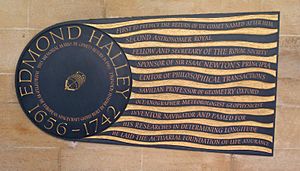
In 1703, Halley became a professor of geometry at the University of Oxford. In 1705, he published his famous paper, A Synopsis of the Astronomy of Comets. In it, he said that the comets seen in 1456, 1531, 1607, and 1682 were all the same comet. He predicted it would return in 1758. As mentioned, he didn't live to see it, but when it did return, it was named Halley's Comet.
In 1716, Halley suggested a way to measure the distance between Earth and the Sun very accurately. He proposed timing how long it took Venus to pass across the Sun.
In 1717–18, he made another important discovery. He found that "fixed" stars actually have their own slow movements. He compared his measurements with old star maps from Ptolemy's Almagest. He noticed that stars like Arcturus and Sirius had moved quite a bit over 1800 years.
In 1720, Halley became the Astronomer Royal, taking over from John Flamsteed. He held this important position until he died in 1742 at the age of 85. He is buried in the graveyard of St Margaret's Church in Lee.
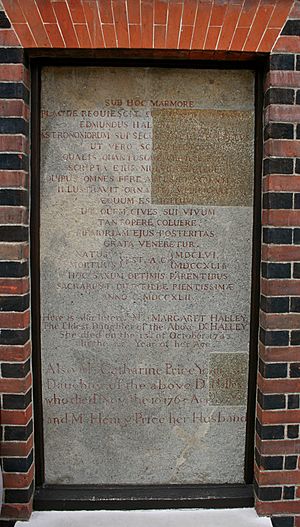
Personal Life
Halley married Mary Tooke in 1682. They lived in Islington and had three children.
Named After Edmond Halley
Many things have been named after Edmond Halley to honor his contributions:
- Halley's Comet (a comet that returns about every 75 years)
- Halley (lunar crater) (a crater on the Moon)
- Halley (a crater on Mars)
- Halley Research Station, Antarctica (a science station in Antarctica)
- Halley's method, for solving math equations
- Streets and roads in various places like Australia, the United States, and London
- The Halley Academy, a school in London, England
In Popular Culture
- Halley's story has been told in documentaries and TV shows.
- He is a character in the 2014 documentary series Cosmos: A Spacetime Odyssey, where he is voiced by Cary Elwes.
- A fictional version of Halley appears in The Magnus Archives, a horror podcast.
- Actor John Wood played Edmond Halley in the TV series Longitude in 2000.
- Halley is also a main character in David Williamson's play Nearer the Gods, which is about Isaac Newton.
- The rock and roll singer Bill Haley named his band "Comets" because of the common way people said "Halley's Comet" at the time.
See also
 In Spanish: Edmund Halley para niños
In Spanish: Edmund Halley para niños


